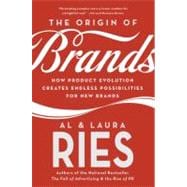
The New copy of this book will include any supplemental materials advertised. Please check the title of the book to determine if it should include any access cards, study guides, lab manuals, CDs, etc.
The Used, Rental and eBook copies of this book are not guaranteed to include any supplemental materials. Typically, only the book itself is included. This is true even if the title states it includes any access cards, study guides, lab manuals, CDs, etc.
The "Great Tree of Life" is how Charles Darwin described hismetaphor for the origin of species.
"The affinities of all the beings of the same class have sometimes been represented by a great tree ... The green and budding twigs may represent existing species; and those produced during each former year may represent the long succession of extinct species. At each period of growth all the growing twigs have tried to branch out on all sides, and to overtop and kill the surrounding twigs and branches, in the same manner as species and groups of species have tried to overmaster ot her species in t he great battle for life."
How do new branches arise? By divergence of existing branches. How do new species arise? By divergence of existing species.
When he was just twenty-eight years old, Charles Darwin jotted down his view of nature in his notebook: "If we choose to let conjecture run wild, then animals, our fellow brethren in pain, disease, suffering and famine -- our slaves in the most laborious works, our companions in our amusements -- they may partake of our origin in one common ancestor -- we may be all melted together."
Melted together, looking backward but spread apart and diverging, looking forward.
The Great Tree of Products and Services
In the "great tree of products and services," how do new categories arise? By divergence of existing categories.
Did you ever see a tree in which two branches converged toform a single branch? Perhaps, but this is highly unlikely in nature. It's also highly unlikely in products and services.
Some Categories Live. Some Categories Die.
Darwin explains: "Of the many twigs which flourished when the tree was a mere bush, only two or three, now grown into great branches, yet survive and bear all the other branches; so with the species which lived during long-past geological periods, very few now have living and modified descendants. From the first growth of the tree, many a limb and branch has decayed and dropped off; and these lost branches of various sizes may represent those whole orders, families, and genera which have now no living representatives, and which are known to us only from having been found in a fossil state."
A branch called typewriter, for example, diverged and formed multiple branches called manual typewriter, portable typewriter, and electric typewriter. Today the typewriter branch has decayed and is about to drop off, overshadowed by a nearby branch called personal computer.
The typewriter is a dinosaur. Today you find most typewriters, slide rules, and adding machines only in a fossil state. That is, in somebody's basement or attic and possibly listed on eBay. (Ebay recently had 1,314 typewriters for sale.)
The sailing ship, the steam engine, and the horse and buggyhave all followed similar paths.
The Great Tree of Brands
If you want to build a successful brand, you have to understand divergence. You have to look for opportunities to create new categories by divergence of existing categories. And then you have to become the first brand in this emerging new category.
In the "great tree of brands," a successful brand is one thatdominates an emerging branch and then becomes increasingly successful as the branch itself expands to block the sunlight fromnearby branches.
Traditional marketing is not focused on creating new categories. Traditional marketing is focused on creating new customers. Traditional marketing involves finding out what consumers want and then giving them what they want, better and cheaper than the competition.
The high priest of a traditional-marketing company is the director of marketing research. To find out what consumers want,companies spend lavishly on research. In a recent year, Americancompanies spent $6.2 billion on marketing research.
(If you've read some of our previous books, you know that we are big believers in public relations, yet PR is only a $4.2-billion business, a third less than marketing research.)
Are We Opposed to Marketing Research?
Yes and no. We're opposed to market research when it attempts to predict the future. This happens when you ask consumers what they will do rather than what they have done.
We're not opposed to market research that explores the past. Why consumers chose the brands they did, for example.
Consumers don't know what they will do until they are actually given the opportunity to make a decision. Another way of looking at the situation is that categories don't diverge until there is an available brand for consumers to purchase.
Today, four out of the five best-selling beer brands are lightbeers. Before the 1975 national launch of Lite beer, what good would it have done Miller Brewing to ask consumers if they would buy a watered-down beer? As a matter of fact, the 1967 launch of Gablinger's should have answered that question with a resounding no.
The Origin of Brands
Excerpted from Origin of Brands: How Product Evolution Creates Endless Possibilities for New Brands by Al Ries, Laura Ries
All rights reserved by the original copyright owners. Excerpts are provided for display purposes only and may not be reproduced, reprinted or distributed without the written permission of the publisher.